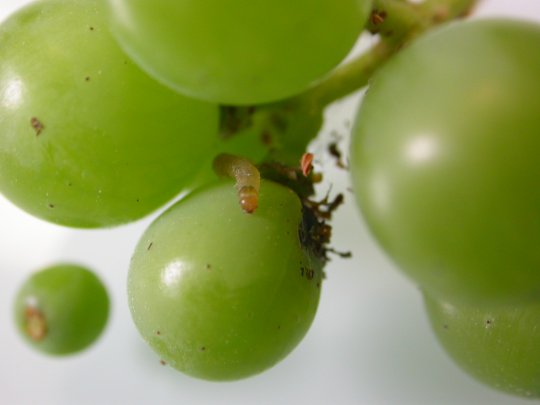Lobesia botrana belongs to the grapevine moth group in the Lepidoptera order. There are three species of leaf roller in France: Lobesia botrana, Eupoecilia ambiguella and Eulia ministrana. The European grapevine moth (Lobesia botrana) has several generations annually which makes it one of the major vineyard pests.
2.4.3.d European Grapevine Moth (Lobesia botrana) and Vine Moth (Eupoecilia ambiguella)
What damage is caused by the European grapevine moth and the vine moth in the vineyard?
The first-generation caterpillars have a low incidence, devouring the flower buds which they assemble using silk threads into "glomerules". The Grapevine moth caterpillar is very agile and fast in its movements.
On average, it forms two glomerules. These attacks do not usually significantly affect the weight of the crop. Subsequent generations of caterpillars cause significantly more damage. They perforate the ripening berries, and create entry points for the establishment and spread of Botrytis cinerea.
How can Lobesia botrana be recognized?
-
Recognizing the eggs: The egg has a lenticular shape, measuring about 0.65 mm. They are flattened and placed separately from each other on the surface of the inflorescences bracts for the first generation, and on the berries for the following generations. Initially translucent, they become yellowish and iridescent.
-
Recognizing the larvae: The caterpillar grows to about 1 cm. It is characterized by very lively movements when disturbed (unlike vine moth larvae). They vary in colour, from yellow-green to light brown with a light brown head.
-
Recognizing adults: The moth is 5-8 mm long and has a wingspan of about 1 cm. They have light colour forewings mottled with brown spots, and greyish hindwings.
What is the biology of the European Grapevine Moth and the Vine Moth
Overwintering takes place as pupae under the bark. The first flight adults emerge from April until the end of May, and create the first generation. Mating and egg laying take place in the twilight hours. Egg laying decreases below 14°C. The egg incubation period varies from 7 to 11 days depending on the temperature. The larvae, after a short lingering stage of a few hours, attack the flower buds.
After five larval stages (20 to 28 days), they pupate (formation of a dark brown chrysalis in the bunches or leaves). Seven days later, the second flight moths appear. This second flight takes place in late June to early July. The duration of this flight is shorter than the previous one.
The females lay eggs on green berries at the pea stage. The caterpillars feed and then dig a passage under the epidermis of the berries to settle there.
The eggs are then deposited on the surface of the berries. Up to three complete generations can follow one another, and the beginning of a fourth generation is sometimes observed. A female lays between 50 and 80 eggs.
Are there any preventive measures?
Mating disruption aims to prevent males and females from coming together and therefore from mating. Eight homogeneous hectares are required to deposit the diffusers (500/ha). These diffusers saturate the air with synthetic sex pheromones (substances emitted by the female to attract the male). This technique requires very careful implementation.
On what basis should control measures be taken?
The following thresholds are indicative and there are different factors affecting control in different regions. In general, monitoring the moths' flights makes it possible to determine when to treat.
-
If there are less than 10 moths in 10 days, no treatment is necessary.
-
If there are more than 10 moths: in the first generation, if there are more than 100 moths per 100 bunches, a curative treatment with a larvicide should be applied. For the second and third generations, the treatment threshold is if more than one bunch has been attacked and botrytis is present, or 10 bunches if there is not much botrytis. Preventive treatment can be applied depending on the damage inflicted by the previous generation and on the flight dates.
Extracts from Vigne Vin Occitanie.


